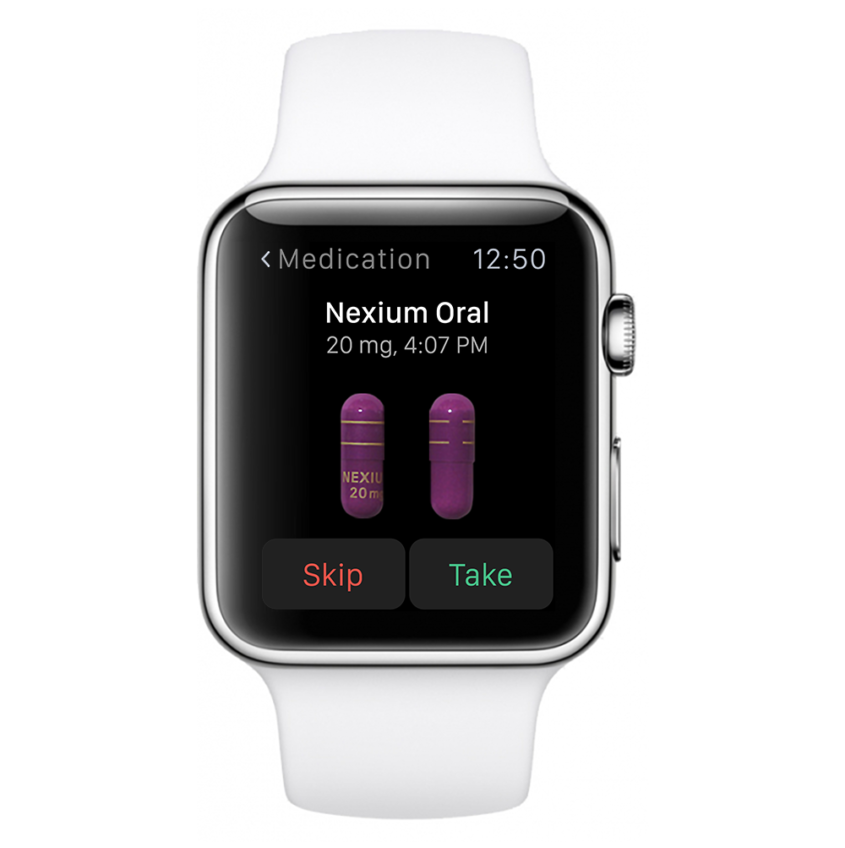WebMD is betting that a glance at its Apple Watch medication adherence app, which is set to launch April 24, will be enough to prod patients to stick with their prescribed treatment regimens.
The hope is that the design, described as “dead-simple” by Benjamin Greenberg, WebMD’s VP of mobile products and user experience, will motivate patients with one message: take your medication.
For now, capabilities to cross-reference the drugs within a regimen to identify possible interactions, send refill reminders, ping caregivers with adherence updates or stream FDA medication updates are not part of the app.
At launch the app will give wearers the opportunity to make one of three choices: take the pill, skip it, or snooze. It will also create a log that can help patients track whether they have taken their medications. The app, which was engineered in-house by WebMD, is expected to take advantage of the watch’s operating system. When wearers scroll through the apps on their watch, they will get notification messages along the lines of “your next pill is in 42 minutes.” One notification would address multiple pills to take at the same time.
 Interested in beyond-the-pill pacts? More info here.
Interested in beyond-the-pill pacts? More info here.
“We’re focused on getting the user engaged by asking them to do nothing: take a pill, tap one thing and they are done. They are not even taking out their phone,” Greenberg said.
He said that the watch is the perfect medication adherence platform because the small screen makes it private and the watch won’t have to be fished out of a pocket. It “removes all friction between the user and the system,” Greenberg added.
Users will need an iPhone to enter information for the smartwatch app. Although WebMD’s app requires users use real drug names, Greenberg said the company tried to address privacy concerns with image options: users can use images from WebMD’s pill library for each medication, or they can swap in an image of their choice. Greenberg said they added a do-it-yourself image option to safeguard privacy so that when a reminder flashes on the watch’s face, other people who are nearby won’t be able to tell the name of the drug or that it’s an alert for a medication.
The Apple Watch adherence app will be free and ads are not part of the current version.
Greenberg said a drug-interaction tracker will probably be added to the app at some point, but the response to the app’s launch will influence the timing of when the next version comes out and what the changes will be.
“The other stuff can come if we feel people need it,” he said.
Other features could include refill reminders, but the add-ons should not detract from the app’s goal, which is to remind patients to take their medications, Greenberg said.
Adherence was a natural starting point for WebMD because it is such a widespread and costly problem. The National Community Pharmacists Association estimated in 2013 that not taking medications correctly and consistently was associated with $290 billion in related healthcare costs. Consulting group Avalere Health reported in 2012 that most patients overestimate their compliance with their medications.
“The idea of having these notifications pop up on a watch, it’s so personal, so instant,” Greenberg said. “That’s how we’re thinking we’re going to make a positive change in people’s lives.”
An app for WebMD’s professional physician audience is also in the works, but Greenberg declined to say when that would be released. The company is considering if they wanted to fuse physician and patient worlds, such as giving doctors access to patient app information and allowing patients to contact doctors through the smartwatch. He said there was no immediate push, similar to how WebMD approached Facebook. “It would have checked all the [social media] boxes, but to do that would have paid no attention to user psychology and what they really want,” he explained.
Competition is already building in the professional space: Doximity, a physician network, is also launching its Apple Watch app April 24.








